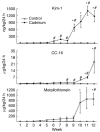Kidney injury molecule-1 is an early biomarker of cadmium nephrotoxicity
- PMID: 17687258
- PMCID: PMC2747605
- DOI: 10.1038/sj.ki.5002467
Kidney injury molecule-1 is an early biomarker of cadmium nephrotoxicity
Abstract
Cadmium (Cd) exposure results in injury to the proximal tubule characterized by polyuria and proteinuria. Kidney injury molecule-1 (Kim-1) is a transmembrane glycoprotein not normally detected in the mature kidney, but is upregulated and shed into the urine following nephrotoxic injury. In this study, we determine if Kim-1 might be a useful early biomarker of Cd nephrotoxicity. Male Sprague-Dawley rats were given daily injections of Cd for up to 12 weeks. Weekly urine samples were analyzed for Kim-1, protein, creatinine, metallothionein, and Clara cell protein CC-16. Significant levels of Kim-1 were detected in the urine by 6 weeks and continued to increase throughout the treatment period. This appearance of Kim-1 occurred 4-5 weeks before the onset of proteinuria, and 1-3 weeks before the appearance of metallothionein and CC-16. Higher doses of Cd gave rise to higher Kim-1 excretion. Reverse transcriptase-polymerase chain reaction (RT-PCR) expression analysis showed that Kim-1 transcript levels were increased after 6 weeks at the low dose of Cd. Immunohistochemical analysis showed that Kim-1 was present in proximal tubule cells of the Cd-treated rats. Our results suggest that Kim-1 may be a useful biomarker of early stages of Cd-induced proximal tubule injury.
Figures






Similar articles
-
Preclinical evaluation of novel urinary biomarkers of cadmium nephrotoxicity.Toxicol Appl Pharmacol. 2009 Aug 1;238(3):301-5. doi: 10.1016/j.taap.2009.01.012. Epub 2009 Feb 6. Toxicol Appl Pharmacol. 2009. PMID: 19371616 Free PMC article.
-
Expression of kidney injury molecule-1 (Kim-1) in relation to necrosis and apoptosis during the early stages of Cd-induced proximal tubule injury.Toxicol Appl Pharmacol. 2009 Aug 1;238(3):306-14. doi: 10.1016/j.taap.2009.01.016. Epub 2009 Jan 31. Toxicol Appl Pharmacol. 2009. PMID: 19371613 Free PMC article.
-
Evaluation of cystatin C as an early biomarker of cadmium nephrotoxicity in the rat.Biometals. 2016 Feb;29(1):131-46. doi: 10.1007/s10534-015-9903-3. Epub 2015 Dec 29. Biometals. 2016. PMID: 26715107 Free PMC article.
-
Comparison of kidney injury molecule-1 and other nephrotoxicity biomarkers in urine and kidney following acute exposure to gentamicin, mercury, and chromium.Toxicol Sci. 2008 Jan;101(1):159-70. doi: 10.1093/toxsci/kfm260. Epub 2007 Oct 13. Toxicol Sci. 2008. PMID: 17934191 Free PMC article.
-
Kidney Injury Molecule-1 (KIM-1): a specific and sensitive biomarker of kidney injury.Scand J Clin Lab Invest Suppl. 2008;241:78-83. doi: 10.1080/00365510802145059. Scand J Clin Lab Invest Suppl. 2008. PMID: 18569971 Review.
Cited by
-
Urinary chemokine (C-C motif) ligand 2 (monocyte chemotactic protein-1) as a tubular injury marker for early detection of cisplatin-induced nephrotoxicity.Biochem Pharmacol. 2013 Feb 15;85(4):570-82. doi: 10.1016/j.bcp.2012.12.019. Epub 2013 Jan 2. Biochem Pharmacol. 2013. PMID: 23291264 Free PMC article.
-
Cadmium Level, Glycemic Control, and Indices of Renal Function in Treated Type II Diabetics: Implications for Polluted Environments.Front Public Health. 2016 Jun 13;4:114. doi: 10.3389/fpubh.2016.00114. eCollection 2016. Front Public Health. 2016. PMID: 27379223 Free PMC article.
-
Iron Oxide Nanoparticle-Induced Neoplastic-Like Cell Transformation in Vitro Is Reduced with a Protective Amorphous Silica Coating.Chem Res Toxicol. 2019 Dec 16;32(12):2382-2397. doi: 10.1021/acs.chemrestox.9b00118. Epub 2019 Nov 11. Chem Res Toxicol. 2019. PMID: 31657553 Free PMC article.
-
Biomarkers of acute kidney injury in children: discovery, evaluation, and clinical application.Pediatr Nephrol. 2011 Jan;26(1):29-40. doi: 10.1007/s00467-010-1576-0. Epub 2010 Jul 10. Pediatr Nephrol. 2011. PMID: 20623143 Review.
-
Bisphenol A Modulates Autophagy and Exacerbates Chronic Kidney Damage in Mice.Int J Mol Sci. 2021 Jul 3;22(13):7189. doi: 10.3390/ijms22137189. Int J Mol Sci. 2021. PMID: 34281243 Free PMC article.
References
-
- Bernard A, Lauwerys R. Cadmium in human population. Experientia. 1984;40:143–152. - PubMed
-
- Fassett DW. Cadmium: biological effects and occurrence in the enviroment. Annu Rev Pharmacol. 1975;15:425–435. - PubMed
-
- Jarup L, Berglund M, Elinder CG, et al. Health effects of cadmium exposure—a review of the literature and a risk estimate. Scand J Work Environ Health. 1975;24(Suppl 1):1–51. - PubMed
-
- Morselt AF. Environmental pollutants and diseases. A cell biological approach using chronic cadmium exposure in the animal model as a paradigm case. Toxicology. 1991;70:1–132. - PubMed
-
- Degraeve N. Carcinogenic, teratogenic and mutagenic effects of cadmium. Mutat Res. 1981;86:115–135. - PubMed
Publication types
MeSH terms
Substances
Grants and funding
- DK072831/DK/NIDDK NIH HHS/United States
- R37 DK039773/DK/NIDDK NIH HHS/United States
- DK 074099/DK/NIDDK NIH HHS/United States
- ImNIH/Intramural NIH HHS/United States
- R01 DK072381/DK/NIDDK NIH HHS/United States
- R33 DK074099/DK/NIDDK NIH HHS/United States
- R21 DK074099/DK/NIDDK NIH HHS/United States
- R00 ES016723/ES/NIEHS NIH HHS/United States
- DK 039773/DK/NIDDK NIH HHS/United States
- ES 006478/ES/NIEHS NIH HHS/United States
- R01 DK039773/DK/NIDDK NIH HHS/United States
- R01 ES006478/ES/NIEHS NIH HHS/United States
LinkOut - more resources
Full Text Sources

